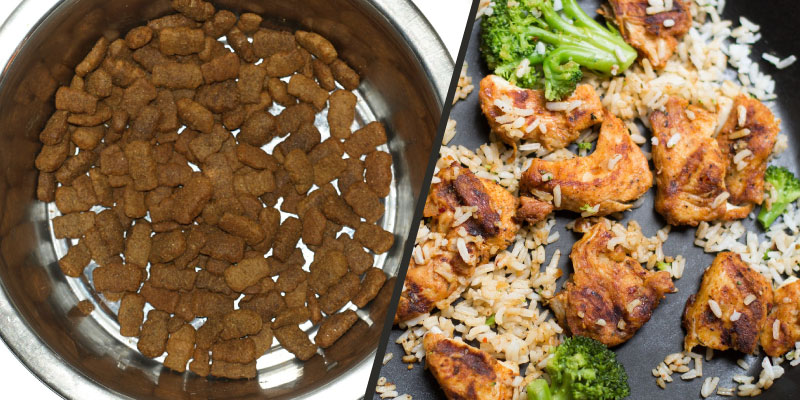There are no two ways about it – looking after a dog is not always easy on the wallet. We take a look at the real cost of making your own dog food at home VS buying it from the shop.
Whether it’s vet bills, toys or just feeding your pooch every week, there are a considerable number of costs associated with being a dog owner.

If you’re looking for a way to reduce your pet bills without compromising your dog’s health, your dog’s diet may be a good place to start. The obvious choice is to downgrade the brand of dog food you’re buying.
This may make food last longer, but it will likely do your dog more harm than good. For starters, lower grade dog food brands are usually bulked up with ‘fillers’ like stodgy carbohydrates, leaving less room for essential nutrients and potentially causing tummy problems.
There’s also the possibility your dog might simply turn its nose up at it – nobody wants inferior food!
As a cheaper, healthier alternative, budget friendly homemade dog food may be the way to go.
Homemade dog food vs kibble – what’s the difference?
Kibble is a simple alternative for dog owners who are short of time. It’s made up of dried dog meats made into small, bitesize biscuits that can be poured easily into a bowl. Some owners feed their dogs kibble only, while others like to mix it up with wet food, gravy, salmon oil or even just meat.
The benefit of kibble is that it’s quick, easy, and has been fortified with all the vitamins and minerals your dog needs to stay healthy. On the downside, some lower grade brands may be bulked up with non-nutritious ingredients, or at worse, with unnatural preservatives that are going to do your dog no favours. Kibble can be very cheap and accessible, but that doesn’t always make it the best.
Homemade raw food
The other argument against kibble is that it involves heating meats to produce the finished product. A new diet that has risen to prominence since the 90s, the BARF diet, posits that raw homemade food is the way forward. It stands for Bones and Raw Food or Biologically Appropriate Raw Food, and some nutritionists claim that heating food strips it of its nutrients and essential enzymes.
For this reason, they recommend a homemade diet of raw food, to include muscle meats, organ meat like liver, eggs, yoghurt, green vegetables and even fruit. This provides the same mix of vitamins and minerals your dog needs for a healthy coat and energetic vigour – with none of the bad stuff.
Is homemade dog food more expensive?
This is a contentious issue, and ultimately, it’s down to your buying choices. When it comes to homemade foods for dogs, you need to err on the side of caution. This is because so much of it involves raw meat. Based on this, it’s best to buy only the highest quality meats, which can be costly.
The second thing that homemade dog food could cost you is your time. Again, this depends how valuable it is to you – you’ll need to spend time doing ‘meal prep’ in the kitchen before you feed your dog. On the plus side, there are plenty of healthy homemade dog food recipes that can be prepared and frozen in advance. All you need to do is defrost them in the fridge 24 hours before serving.
For those will a little extra budget and no time, you may even be able to get raw Dog food, or gently cooked fresh dog food, delivered directly to your door in daily or weekly batches. This saves you time, but is undoubtedly the most expensive option.
How to choose the most affordable homemade dog food
You could find that you save yourself a substantial amount of money when switching to homemade food. If you’re prone to buying expensive brands, buying in bulk or throwing out dog food that’s not been eaten, the pennies could quickly add up.
Buying natural ingredients is just the same as adding to your weekly shop. It may even save you money on delivery costs (no more help needed carrying huge kibble bags!) or save you time visiting specialist pet stores.
To keep your dog dinners within your budgets, try these tips:
- Get your meat from the local butcher. This is oftentimes cheaper than supermarkets and will be markedly higher in quality. What’s more, once you’ve built up a friendship with your butcher, you may find he/she even throws in extras or gives you ‘scraps’ (which are totally fine for dogs but perhaps less appealing to humans) for free or for lower amounts.
- Think about how you’re emulsifying your foods. A classic homemade dog food recipe will result in handmade patties. You can stick these together with high-cost emulsifiers like olive oil, but you’ll get the same result and health benefit from using low costs eggs.
- Buy items that won’t go out of date in bulk. For example, flaxseeds provide huge nutritional benefits for dogs, particularly for their digestive systems. You can store these for a good amount of time and get reduced rates when buying online or from wholesalers.
- Try frozen. As we mentioned above, you can freeze homemade dog food recipes, so you can also use frozen vegetables in your food prep. Often these are a healthier choice for your dog – they’re frozen at source from the moment they’re picked, so you know they’re fresh. What’s more, they’re also lower in sodium than pre-packaged dog foods or tinned vegetables.
- Buy fresh ingredients and then freeze the patties. You can save time and money, ensuring no meat goes to waste, by doing ‘meal prep’ at the beginning of the week.
Try this homemade dog food recipe
You can vary the amounts for each ingredient depending on the size of your dog.
No serving should weigh more than 2% of your dog’s body weight.
Add raw beef, eggs, yoghurt, flaxseeds, spinach, chopped apple and carrots together. You can even spice it up with organ meats like liver. Make sure it’s all blended together in a food processor, and add a drop of olive oil if it’s not sticking. Ensure at least 25% of the recipe is protein and meat.
Worried about how to flavour homemade dog food? If you’re slowly making the transition, your dog may need some convincing. You can season your recipes with chopped tomatoes, cayenne pepper (in very small servings!) or parsley.
Each of these has its own nutritional benefit, from heart health to anti-inflammation. Avoid onions and common dog food around the house which are poisonous to dogs at all costs – these include things like macadamia nuts, grapes and raisins.
What to know before you switch to homemade food
When done right, homemade food can be a budget-friendly alternative to pre-packaged dog food. However, you have to be committed to spending time preparing your meals, and the change might come as a shock at first. If you are making the switch, remember:
- Introduce the new diet slowly – try building up by adding the raw food to his usual food a little at a time, building up to one meal per day to avoid stomach upsets.
- Only use high-quality fresh meat to avoid the danger of bacteria in raw food
- Don’t switch back to store-bought dog food straight away, as this could upset your dog’s stomach even more
- Keep an eye on how your dog’s health changes – look at the silkiness of its coat, its skin, teeth and size of stools
- Make a budget checklist before you commit to changing the diet. You should weigh up the costs of dog food versus homemade ingredients to avoid any nasty shocks.
We all want what’s best for our dog, but this comes with sacrifices. If you’re willing to put in the hours, you may just find that homemade food pays for itself.




